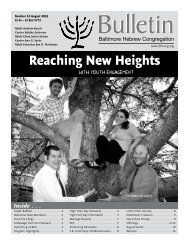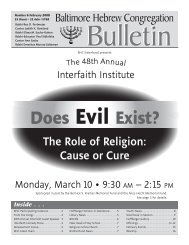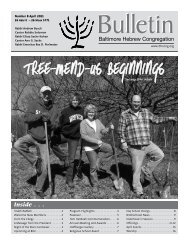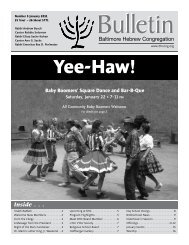A Fond Farewell to - Baltimore Hebrew Congregation
A Fond Farewell to - Baltimore Hebrew Congregation
A Fond Farewell to - Baltimore Hebrew Congregation
Create successful ePaper yourself
Turn your PDF publications into a flip-book with our unique Google optimized e-Paper software.
Blurring the Division Between East and West: Indo-Judaic Relations<br />
Article and pho<strong>to</strong>s submitted by Ben Piven. Ben (BHC Bar Mitzvah ’96, Confirmand ’99) is currently a U.S. Fulbright Scholar living in India and doing research on<br />
the cultural geography of the caste system in Mumbai (Bombay). After completing his 9-month study, Ben will attend the Columbia University Graduate School of<br />
Journalism starting in Fall 2008.<br />
As a Jewish-American researcher in this exhilarating country of stark contrasts, India strikes me as vivid, voluminous, and variegated. While<br />
the primary focus of my research project is on Dalits (formerly Un<strong>to</strong>uchable castes) in Mumbai, I have also had the opportunity <strong>to</strong> explore<br />
various Jewish themes during my time in India.<br />
Global Context of Warming Relations<br />
In recent years, there has been a tremendous warming of relations between Jews/Israel and Indians/India, with the U.S. providing a conduit.<br />
The increased linkages have taken on business, <strong>to</strong>urist, military, and geopolitical dimensions. Relations are more intimate than ever. The<br />
end of the Cold War meant a significant shift in alliances, especially with regards <strong>to</strong> the<br />
rise of Islam. Moreover, the Indian economy liberalized, and the Indian government has<br />
been moving ever closer <strong>to</strong> the U.S. on the global stage. Along with increased cross-cultural<br />
understanding, many Indians view America as a land of incredible opportunity, while<br />
Americans often see India as curiously exotic. There is also a very profound Israeli obsession<br />
with India, and Israeli <strong>to</strong>urists, especially post-military service, are ever-present on the<br />
subcontinent. One further similarity is that the <strong>Hebrew</strong> and Hindi languages have borrowed<br />
extensively from both English and Arabic.<br />
Jewish Connection with India<br />
The various Semitic/Middle Eastern<br />
influences on Indian culture include Mughal<br />
Islamic influence in North India and Syrian<br />
Christian heritage in South India. Moreover, Ben Piven, center, with a family during the<br />
there is increasing his<strong>to</strong>rical knowledge of Diwali celebration (Festival of Lights)<br />
the five Indian groups practicing Judaism in<br />
various ways and whose Jewish descent ranges from literal <strong>to</strong> far-fetched. In chronological<br />
order of emergence, they are: Cochin Jews (Kerala), Bene Israel (Maharashtra), Baghdadi Jews<br />
(Mumbai, Kolkata), Bnei Menashe (Manipur, Mizoram), and Bene Ephraim (Andhra Pradesh).<br />
I have been fortunate enough <strong>to</strong> encounter the former three communities, whose Jewish<br />
origins are indubitable – while the latter two communities have emerged more recently.<br />
Nonetheless, many Bnei Menashe have migrated <strong>to</strong> Israel. The Telugu-speaking Bene<br />
Ephraim are notable because they are members of an Un<strong>to</strong>uchable caste (Madigas) who have<br />
promoted liberation from low-caste Hinduism through Judaism and migration <strong>to</strong> Israel.<br />
The Star of David, Diwali mandala sand painting<br />
Moreover, there is ongoing Jewish religious interest in Hindu rituals, yoga practice, and<br />
Buddhist meditation. An additional cultural link is the Star of David and the related Sri<br />
Yantra, which are omnipresent symbols in India. Speculative theories about ancestral linkages involve various Semitic-sounding placenames<br />
in India that are attributed <strong>to</strong> Hebraic rather than Arabic roots and particular Indian castes/communities (Yadavs, Kashmiris)<br />
for whom distant Jewish origin is claimed, generally through some version of the 10 Lost Tribes of Israel hypothesis. Another common<br />
theme for Indo-Judaic researchers is Abraham’s purported a-Brahmanism, which attributes the etymology of his name <strong>to</strong> his being an<br />
“a-Brahm.” Such folks argue that monotheistic Abraham emerged from the ancient Vedic tradition of Northwest India and migrated<br />
westward <strong>to</strong>wards Canaan because he rejected the precepts of Brahmanism. Even if this<br />
theory is far-fetched, the distinction between so-called Dharmic and Abrahamic faiths is<br />
not always so clear-cut.<br />
Jews & Brahmins<br />
There have also been conspira<strong>to</strong>rial comparisons drawn between the “Jews of India”<br />
(contemporary Brahmins) and actual Jews, which concentrate both on political alliances<br />
and on demographic minority status. Though Brahmin-baiting and anti-Semitism both have<br />
varied avatars, Brahmins are viewed as similar in their attainment of economic resources<br />
and political influence, both in India and abroad. Yet, reactionary sentiment <strong>to</strong>wards Jews<br />
is comparatively very rare in India, due <strong>to</strong> the lack of Hindu proselytizing and the long<br />
tradition of Indian religious <strong>to</strong>lerance.<br />
Kohens & Brahmins<br />
One additional area of interest lies in the priestly caste, which exists in both Hinduism and<br />
Judaism. Despite significant difference between Kohens and Brahmins, certain parallels<br />
abound. Although there are more vestiges of Brahminical privilege extant in contemporary<br />
Hinduism, some features of Kohen status still serve <strong>to</strong> differentiate the priests of the ancient<br />
<strong>Hebrew</strong> temple. Judaic society was never caste-stratified by lineage in the same way as<br />
Hindu society, but the priestly caste of yesteryear retains special distinction in both cultural<br />
spheres. In conclusion, the numerous connections between Abrahamic and Dharmic The Star of David—an “Om Star” on a temple<br />
cultures blur the divisions between East and West.<br />
in Kerala<br />
<strong>Baltimore</strong> <strong>Hebrew</strong> <strong>Congregation</strong> Bulletin • Number 7 • 24 Adar I – 24 Adar I1 5768 • March 2008<br />
5















